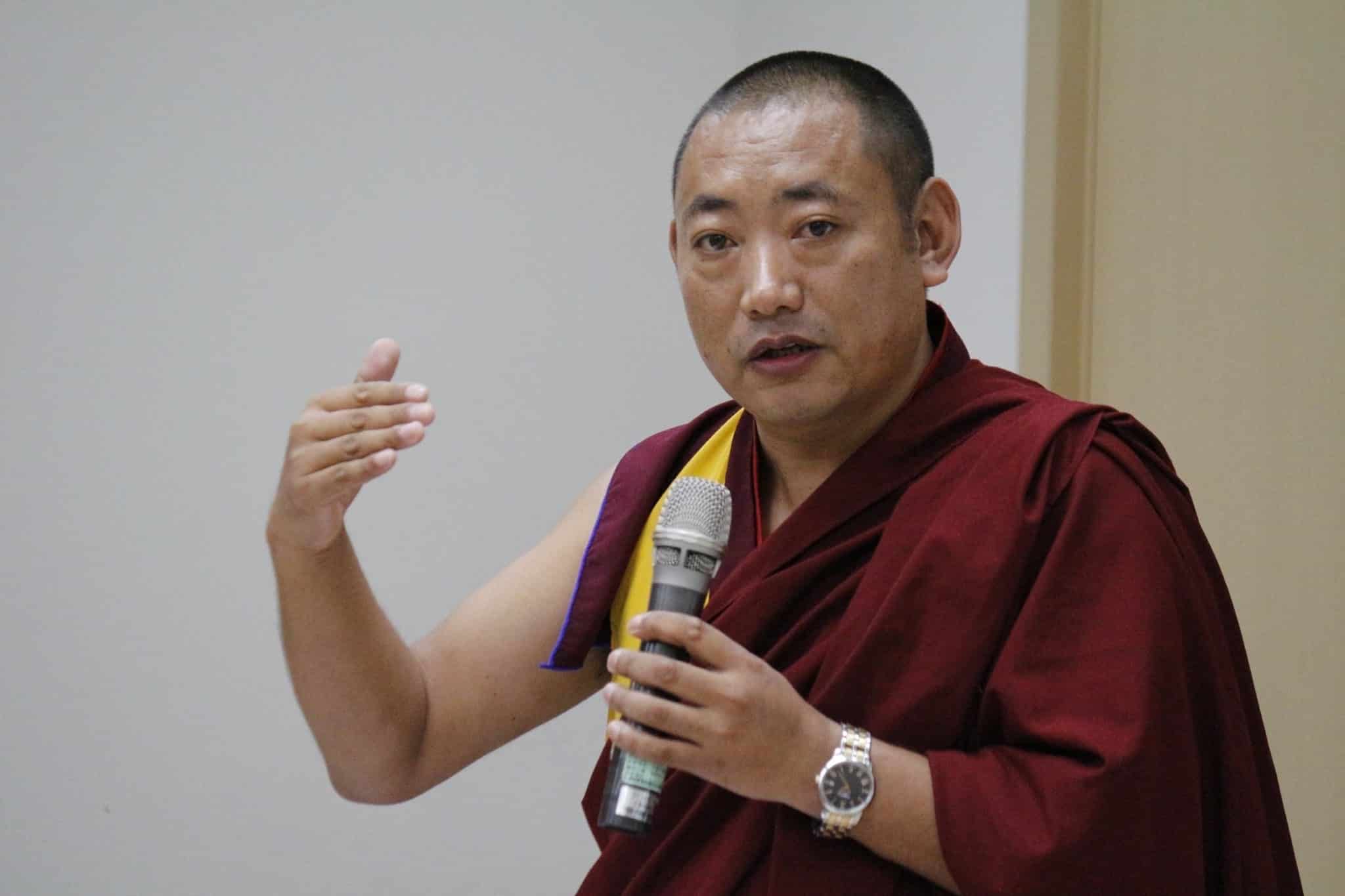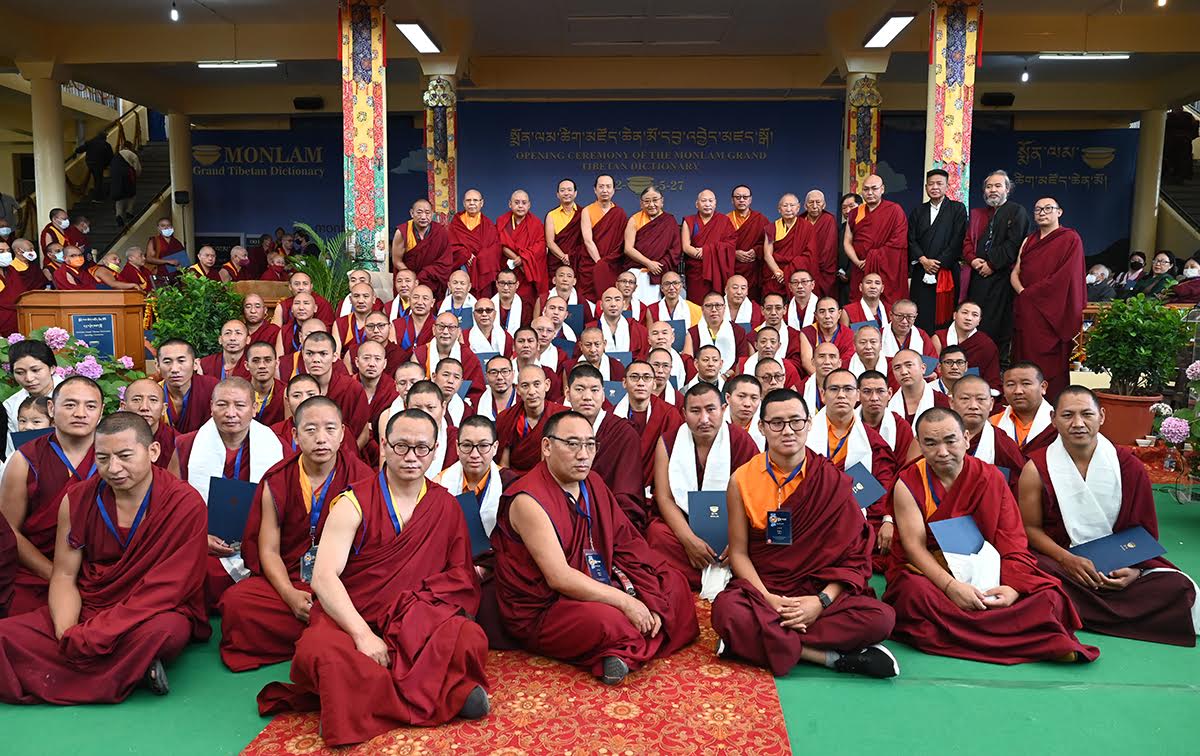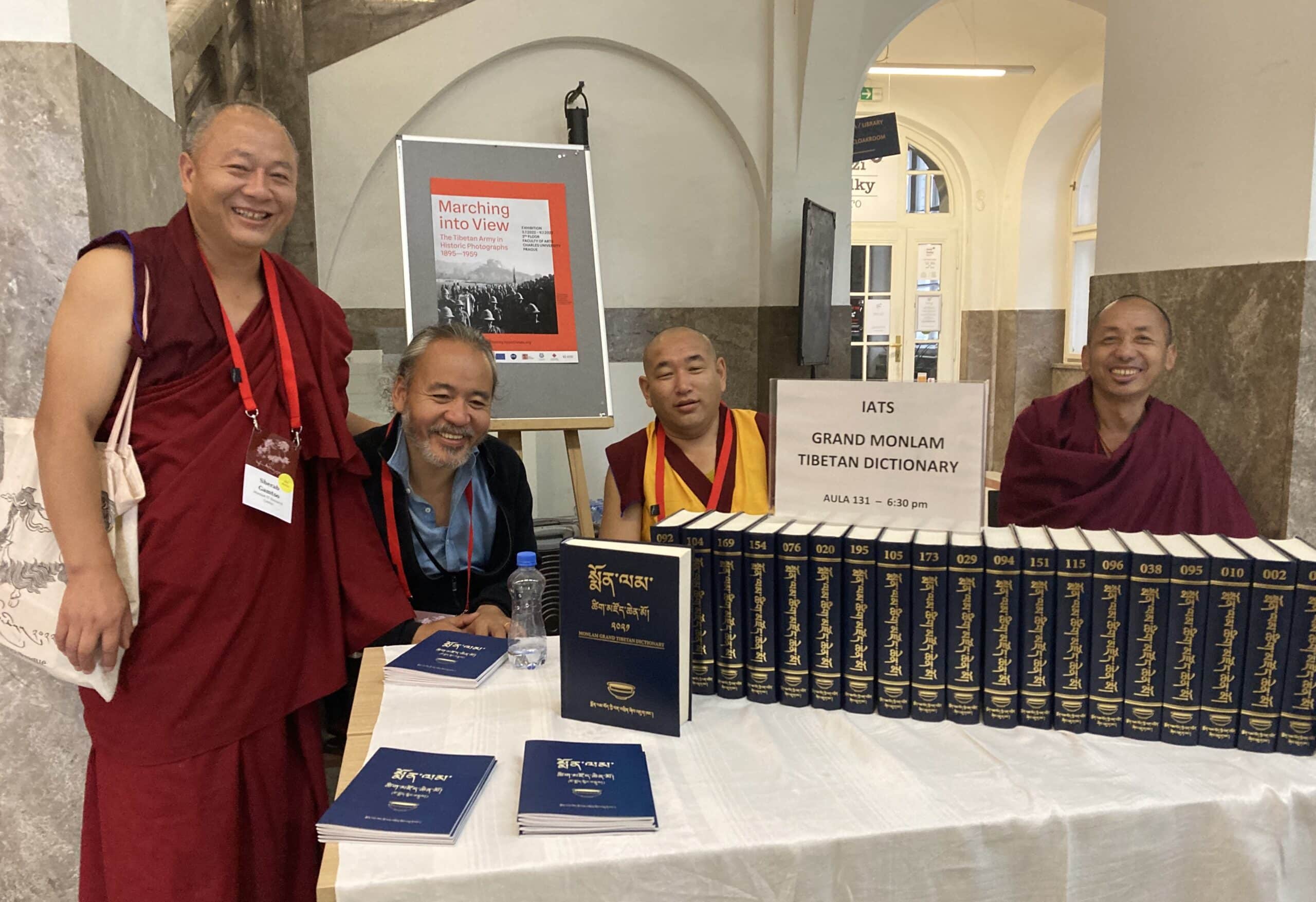
Geshe Monlam giving a talk about the Monlam Dictionary project, in Taiwan. Courtesy of Monlam IT.
In 2022, Geshe Monlam and his team of more than 150 editors and staff published the Grand Monlam Tibetan Dictionary, containing Tibetan-language definitions for over 360,000 words. It was an unprecedented achievement. When printed in book form the current version of this evolving dictionary came to 223 volumes. Through a recent interview with Geshe Monlam, we learned that the man behind this terrific work is a modern day Renaissance man. Read on.
Around the years 2000-2002, the monks of Sera monastery in south India needed a new assembly hall. One of their young monks, Lobsang Monlam, by then already knew how to make Thangka paintings. Like a young Leonardo da Vinci, he was interested in sketches and plans, and drawing and design. And because the monastery needed it, without knowing anything about architecture, he planned and designed the Sera Mey assembly hall. The hall was then built according to his design. This is the hall where thousands of monks of Sera Mey gather to meet, to pray, to be together. It's the very heart of the monastery.
That was how it all started. Because of this work, Geshe Monlam received some gifts of monies from monastery sponsors and well-wishers. With this money, he was able to buy his first computer, teaching himself how to use it and then how to make software. His first computer creation to go viral was a suite of Tibetan fonts in a wide variety of styles and scripts that he shared for free. These fonts enabled Tibetan writers and desktop publishers to be more expressive with the appearances of their productions.
It's incredible how little time it took Geshe Monlam to go from simply learning how to use a computer to developing the much needed Monlam Tibetan font and now creating the greatest Tibetan dictionary in the world. The publication of the Grand Monlam Dictionary was a milestone in Tibetan literature, and we are delighted that it's now available on BUDA where it can be used to look up the meaning of every word in our vast e-text archive.
Of course, the historical figure that Geshe Monlam most brings to mind is not Leonardo da Vinci, but James Murray, the great lexicologist and primary editor of the Oxford English Dictionary. What Geshe Monlam has done for Tibetan is arguably even more profound and impactful than what James Murray did for English.
We spoke with Geshe Monlam, the visionary behind this milestone project.

At the launch of the Grand Monlam Tibetan Dictionary at Tsuglagkhang Temple in Dharamsala, May 2022. A group photo of Geshe Monlam and his team with Sakya Gongma Trichen Rinpoche, 43rd Sakya Trizin Gyana Vajra Rinpoche, 42nd Sakya Trizin Ratna Vajra Rinpoche, 34th Menri Trizin Rinpoche, Yongzin Ling Rinpoche, Samdhong Rinpoche, Ven Ringo Tulku, and leaders of the Central Tibetan Administration. Photo by Tenzin Phende, DIIR.
How did the Monlam Dictionary start?
Once I had enough money, I was able to buy my first computer. Then I started learning how to use it, and I became really interested in everything the computer could do. I kept exploring and learning. In 2004, I began to make software and started working on a Tibetan font for the computer and the next year, Monlam Bodyig Tibetan Font was published. Then later came Monlam Bodyig Version 2 and Version 3.
In 2008, Monlam Bodyig 3 was launched by His Holiness the Dalai Lama, actually. His Holiness invited me to Dharamsala and encouraged me to keep working on this Monlam Bodyig project, which he thought was very important. With his support, in 2012, we established the Monlam Bodyig Research Center and began working on a major new project, which was the Monlam Grand Tibetan Dictionary.
This Monlam Grand Tibetan Dictionary project, which took 9 years, was undertaken with the advice of His Holiness the Dalai Lama. This project involved the labor and efforts of over 150 people over a long period of nine years. We finally finished the project in 2021, but delayed a formal launch because of the Covid pandemic. In 2022, we had a launch event in Dharamsala at Tsuklagkhang Temple with thousands of people.
The Dictionary is launched but actually, we still continue our work with Monlam Dictionary. We will work on this for another ten years to keep updating the Dictionary. Actually more dictionaries are being planned. We will make an English to Tibetan dictionary and a Tibetan to English dictionary, Chinese to Tibetan and Tibetan to Chinese dictionaries, and German to Tibetan and Tibetan to German dictionaries etc. We are also working on an Elementary and Intermediate Tibetan dictionaries, for language learners, which will have pronunciation as well. Tseten Dolkar la of Radio Free Asia is doing the pronunciation work for these dictionaries.
What is your most important accomplishment? Can you tell us a little bit about that?
I have created 37 different computer applications, and these are all apps that are given for free to the people and the public. I made these, because it was something small that I could do to help Tibetan society. I am happy that I was able to do my work to promote and sustain Tibetan language and culture.
These apps that we made are all related to Tibetan language and culture, and we needed data. We needed words and descriptions, so working on these apps, it became clear to us that we needed to create a dictionary. That was the first and most important thing.
When the Indian Panditas first came to Tibet over a thousand years ago, the first thing on the agenda was always creating a dictionary. It was the dictionary that then allowed them to carry out all their subsequent works. From the 8th century onwards, they first created the Drajor Bampo Nyipa (Madhyavyutpatti), which had about 600 or 700 entries. This was the very first dictionary, so it didn't have a ton of terminology but it was an amazing achievement. The way that they made that dictionary, and the rules they created around it—it was so standardized and systematic and set a model for everything that came after it. The next one, Jedrak Tokjo Chenpo, had around 8000 terms. The translators and the royal family and scholars and monks—these involved the labor of so many over a period of time. And we still use them today.

Several volumes of the 223 volume Grand Monlam Tibetan Dictionary were on display at the International Association of Tibetan Studies conference, Prague 2022.
And now you have the Grand Monlam Tibetan Dictionary! Why is this dictionary important?
Information technology is important for Tibetans. It's important for the Tibetan language to be up to current standards regarding information technology. We need to develop Tibetan language technology to bridge the gap between technology and the Tibetan language. And to do that, we need to have all the words and vocabulary.
When we looked at the dictionaries before 2012, there were around fifty something dictionaries created so far historically. They were similar in nature, and all of these were made by one or two persons, so the dictionaries were necessarily limited in scope. We needed an online dictionary; that was the original plan. And the important thing about the Monlam Dictionary is that it was a sustained communal effort; all the different traditions were involved in creating the Monlam Dictionary, and each tradition worked on their own terminology. So for example, the Bonpos worked on their own terms and vocabularies; after all they can explain it best.
The other important thing is that we were following the rules of lexicography. It needed to be a really standard dictionary. So then we made a 9 year plan, with different sections of people–scholars and translators and experts–working on parts of the dictionary. Finally in 2022, we launched the Monlam Dictionary to the Tibetan public, and to the world public.
Can you say something about how BDRC has been useful to your project?
BDRC is an extremely useful resource. As you know, it's the largest online resource of its kind and the largest Tibetan library on the internet, with a vast and diverse collection of Tibetan texts. It's a great source to consult because of its breadth and diversity of material.





Sorry, the comment form is closed at this time.